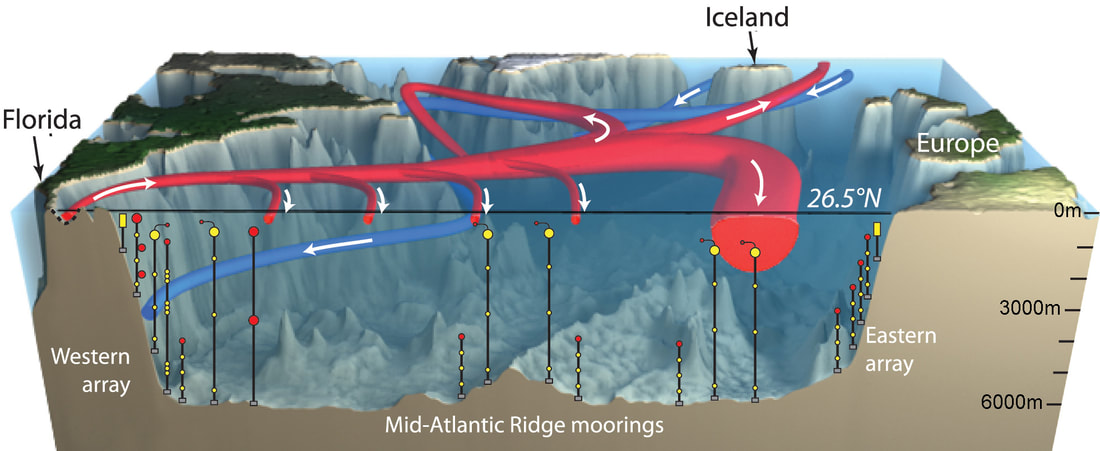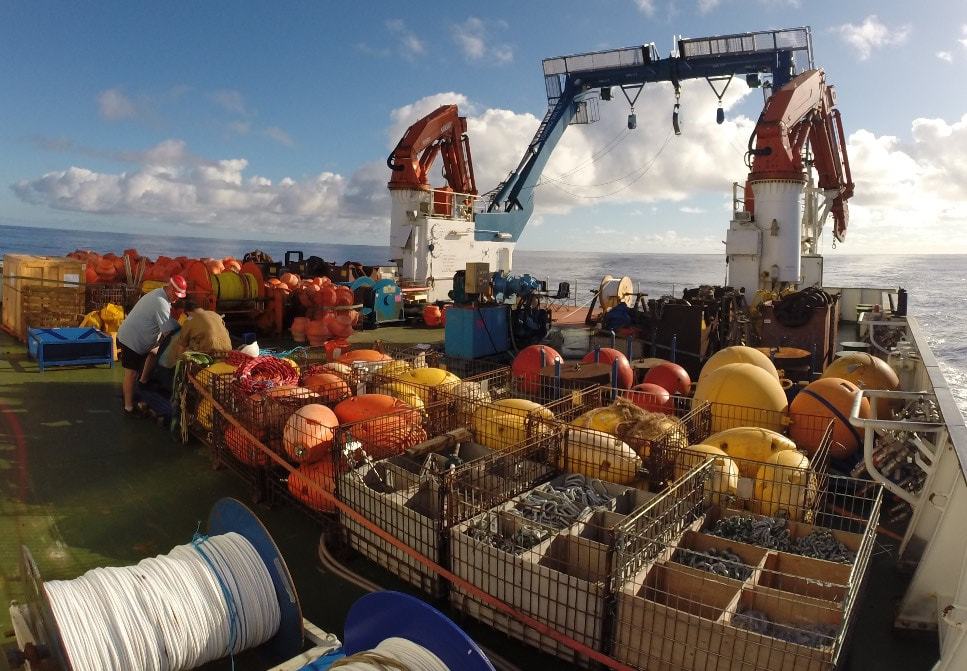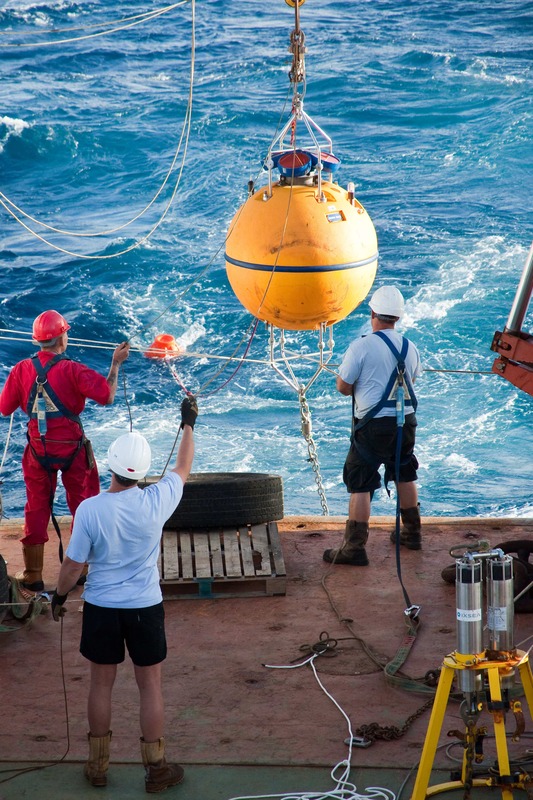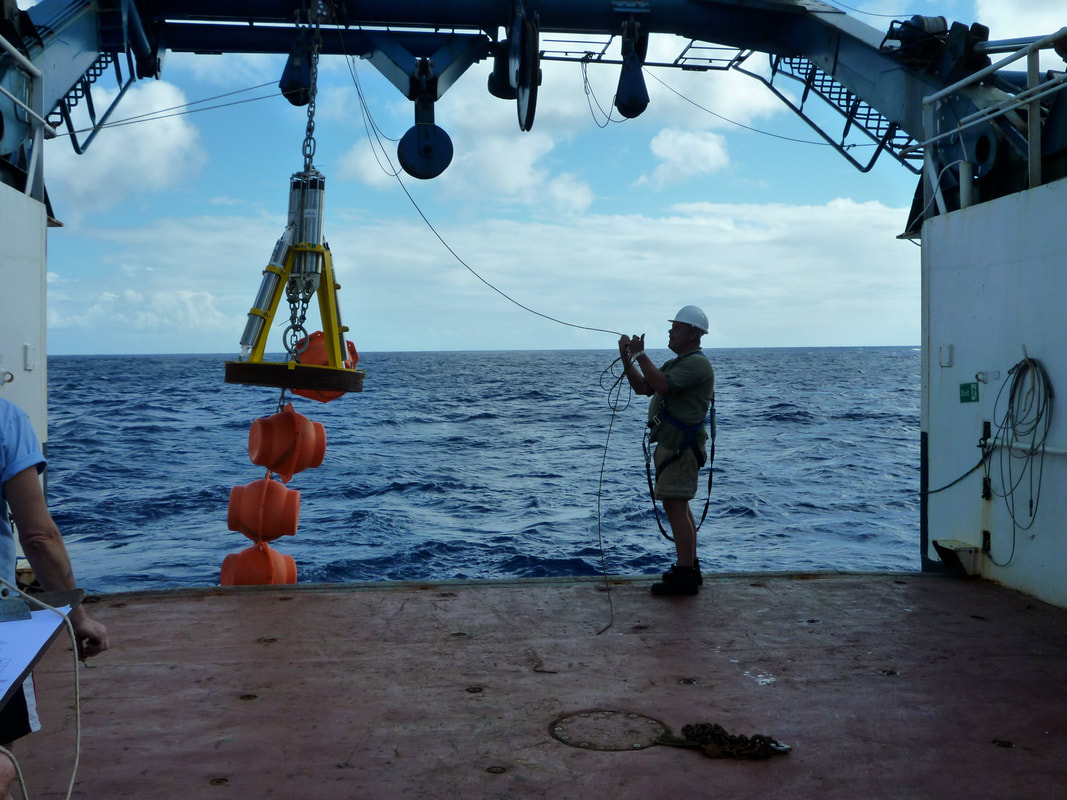|
Sound Waves >>
|
5.3 - Deep Sea Moorings
Objectives:
- To understand the concept of a deep-sea mooring and its uses and limitations.
- To know about two of the more well-known mooring arrays and their purposes.
|
One of the ways to overcome one of the problems of the shipboard CTD is to lay a deep sea mooring, so that, while it is still a single point in the ocean, it is possible to see how the oceanic variables change as a function of time. I was heavily involved in the deep sea moorings for the RAPID MOC project in 2009/10. The moorings are covered with instruments and lowered to the seabed and are usually recovered a year or so later. The RAPID moorings were up to 4500 m long and used old locomotive wheels as anchors.
Deep sea moorings are very long length of wire that have instruments attached to them at intervals all the way down. They must also have an anchor to hold them in place and buoyancy to hold the mooring up. They may or may not have a floating buoy at the surface. The anchors are often old train wheels welded together. If the mooring is more than about 100 m deep, the wire is attached to the anchor using an acoustic release. These are battery operated devices that have jaws at one end that connect to the anchor. When they receive an acoustic (sound) signal from the ship at the surface, they open their jaws and release from the anchor. The mooring is then pulled to the surface by the buoyancy. For really deep or critical moorings, the releases are doubled up. So if one fails, the other will release the mooring. Acoustic releases must withstand enormous pressures and cold temperatures for up to two years without failing, so they are very expensive. Buoyancy is critical too. A boat mooring in a harbour consists of a chain attached to a heavy weight with a hollow plastic ball at the surface. This can't work for a deep sea mooring, the depths are just too big. A mooring in 6,000 m of water would require an enormous amount of chain with an equally enormous top float. This is prohibitively expensive. Instead, the mooring wires with have many small buoyant spheres spread over intervals up the length of the wire. As these will be subjected to very large pressures, they must be very strong. They are often hollow spheres of high quality glass, about 18" in diameter and covered in a plastic 'hard hat' so that they can be shackled onto the mooring. The walls of the glass sphere are about 2" thick. The spheres come in two hemispheres, which are held together by pressure. The joins are ground smooth and greased. The hemispheres are heated so that the air inside is hot, then they are pushed together. As the air inside cools the pressure drops and the two halves are held together by atmospheric pressure. Once below the surface, the water pressure holds them tight. If they leak, implosion is almost instant. As most materials with air spaces (foam) that are buoyant would be crushed in the deep ocean, special materials have been developed for some applications - known as syntactic buoyancy. To deploy a mooring, the ship is slowed down before reaching the location. The top float is attached to the mooring cable and put into the sea. As the ship slowly steams away the mooring cable is paid out. The crew mount buoyancy and instruments to the cable as it is deployed. Finally, once the acoustic releases have been attached, the anchor is lifted up by a crane at the stern and held in place until the ship has reached the mooring location. Then the crane hook is released and the anchor rapidly sinks, dragging the mooring behind it. It is very important to know where the mooring was dropped, so that it can be found again when it is time to pick it back up. Usually, there is no float on the surface as the wave action would put too much stress on the gear. When it is time to recover the mooring, the ship heaves to at the drop site. The crew lower an acoustic transponder over the side and try to contact the acoustic releases. This can be nerve wracking, because they have failed, the mooring is lost. Once communication has been verified, the signal is sent to release the anchor. The ship backs away as the mooring comes to the surface. Once the mooring has surfaced, the ship moves in and the crew grapple the top float (often has a flag on it!). The mooring is brought aboard and the instruments removed and downloaded. |
Video: deploying the first RAPID MOC mooring array in 2004. This shows how a typical deep ocean mooring is deployed and recovered.
|
The advantages of a mooring is that you get great temporal resolution - lots of measurements throughout the year or so that it is operational rather than a single measurement in time that is measured by a shipboard CTD. Therefore, oceanographers can see how the water column changes with time. At the moment BIOS is sending a ship out to a site 50 nm off the island every month to make a time series measurement. As it is only a short distance away, it maybe cheaper to use the ship than deloy a mooring - and less risky. This temporal resolution argument is mentioned in the RAPID video. The 2004 ship measurements recorded a major slow down in the Atlantic Circulation. This worried a lot of scientists who thought that the predicted effect of climate change was happening far faster than anticipated. As it turned out, the drop was a seasonal effect that was undetected by the few historical ship observations.
The disadvantages of a mooring are that they are very expensive and time consuming to prepare and deploy, sometimes they are lost and are not there when the ship returns and the data is not recovered in real time.
The disadvantages of a mooring are that they are very expensive and time consuming to prepare and deploy, sometimes they are lost and are not there when the ship returns and the data is not recovered in real time.
Sound Waves >>




